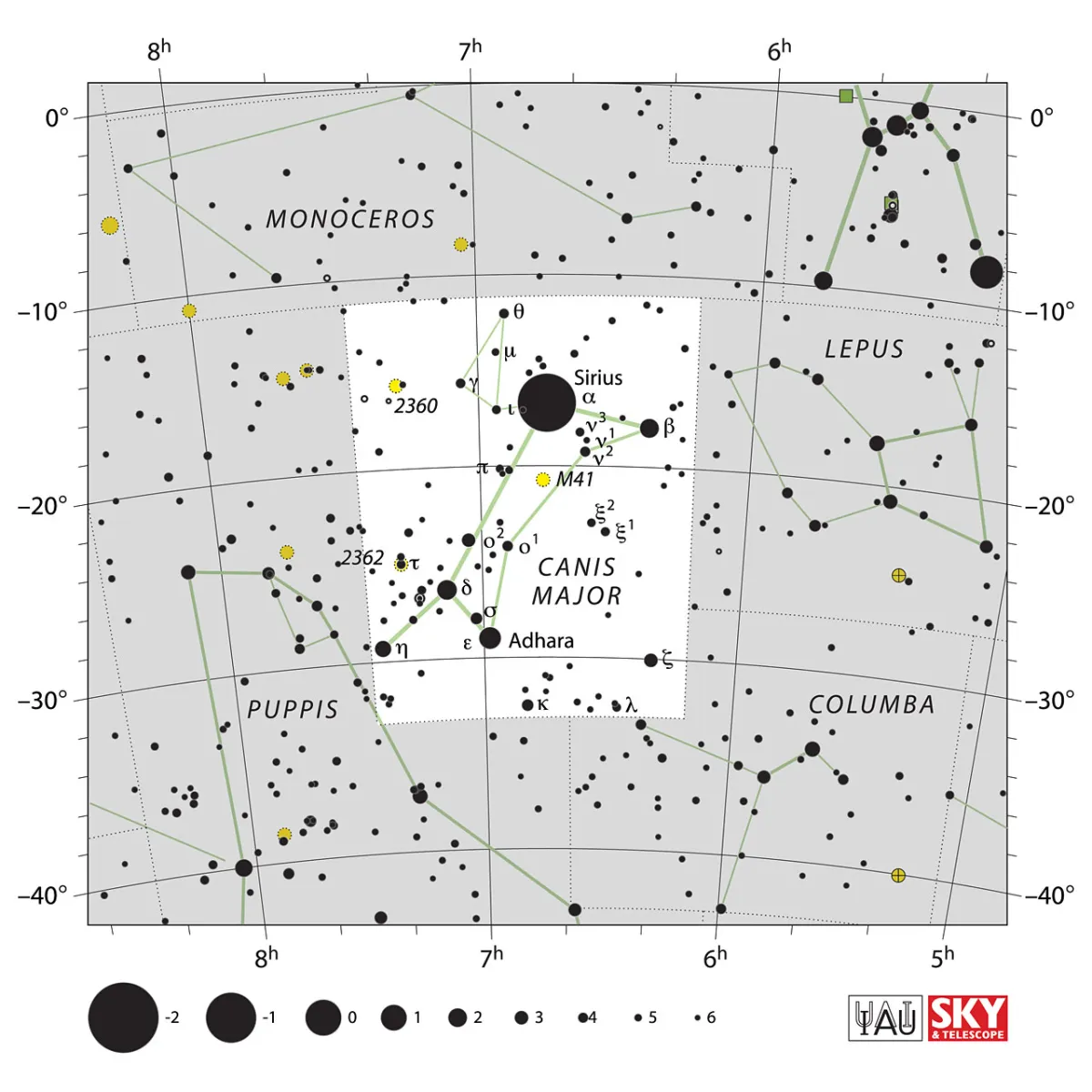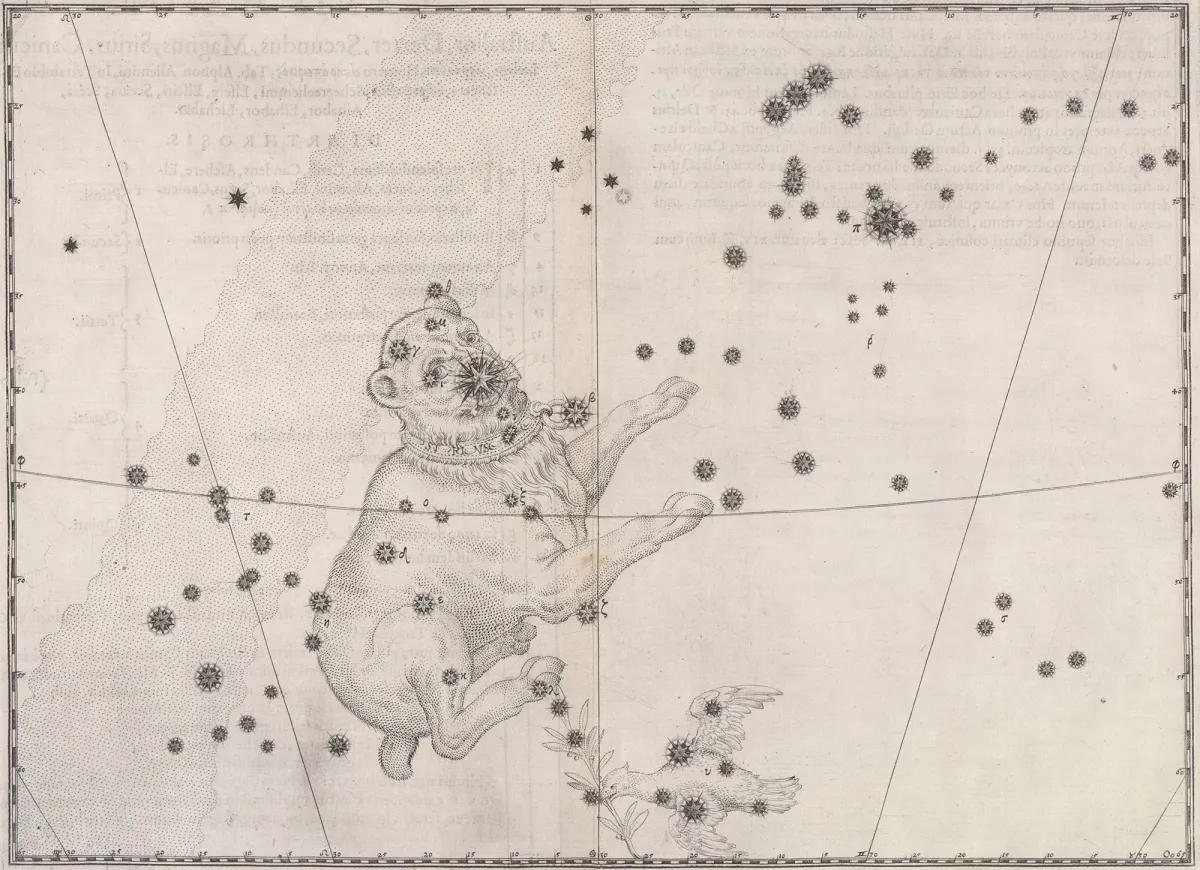Constellation Canis Maior (Great Dog)

Properties
Canis Maior is a typical winter constellation and is located southeast of Orion. The constellation is very noticeable as it contains the brightest fixed star in the firmament, Sirius. If you extend Orion's belt to the southeast, you come across it directly.
The star Sirius forms the winter hexagon together with Procyon, Castor and Pollux, Capella, Aldebaran and Rigel. The area of Canis Maior is 380 square degrees and it culminates at midnight on around January 1st.[9, 15]
| α CMa | Sirius, Canicula, Dog Star, Aschere |
| β CMa | Murzim, Mirzam, Mirza |
| γ CMa | Muliphen, Muliphein, Isis, Mirza |
| δ CMa | Wezen, Alwazn, Wesen, Al Wazor |
| ε CMa | Adara, Adhara |
| ζ CMa | Furud, Phurud |
| η CMa | Aludra |
| IAU Name | Canis Maior |
| IAU Genitive | Canis Majoris |
| IAU Abbr. | CMa |
| English Name | Great Dog |
| Culmination at local midnight | 3 January |
| Season (Latitude +0.0°) | September … June |
| Right Ascension (J2000.0) | 06h 11m 36s … 07h 27m 54s |
| Declination (J2000.0) | -33° 15' 02" … -11° 01' 49" |
| Area | 380 deg2 |
| Neighbours (N↻) | Mon, Lep, Col, Pup |
Deep-Sky Object Descriptions
Catalogues
Mythology and History
Canis Maior is an ancient constellation that depicts one of the dogs that follow on on the heels of the sky hunter Orion. The other dog is Canis Minor. [7, 10, 20, 21, 25]

Another, somewhat questionable interpretation is that of the hellhound Kerberos: Echidne and Typhon were the parents of Kerberos. Half of Echidne's body was a beautiful woman, the other half a stained, disgusting snake; she lived in a deep cave and ate only sweet human flesh. Typhon was the worst monster you can imagine; his legs were writhing snakes, his arms had snakeheads in place of his hands, a hideous donkey's head was his head, and smoking lava erupted from his mouth when he opened it. Echidne and Typhon fathered several children, including Kerberos, who inherited some of his parents' physical characteristics. Mostly he is described as three-headed and several stitches depict him in a realistic way. Snakeheads grew out of his back and his prickly tail, which he could whip and move, was a dangerous weapon. This Kerberos lived in the underworld and his job was to devour anyone who tried to escape from the underworld and not to let any living mortal enter the underworld. But Heracles succeeded - this was his twelfth task which Eurysteus entrusted to him - to tie Kerberus with diamond-hard chains and to pull him out of the underworld. The beast barked wildly as soon as it was brought into daylight, and disgusting drool spurted out of all its mouths on meadows and fields, and a poisonous plant - it was the blue monkshood - grew from every drop of the contaminated saliva. The world was glad when Hercules brought this beast back to Hades. [20]
The constellation was named Canis, Canis Syrius (after its main star Sirius) and Canis Australior (because of its location south of the celestial equator), but also Kerberos and Ianitor Lethaeus (doorkeeper of the underworld). An attempt was made to give this constellation a biblical interpretation, but it never caught on. The hunting dog of Orion or the bloodthirsty Kerberos was reinterpreted as the tame dog of Tobias or completely as Saint David. [20]